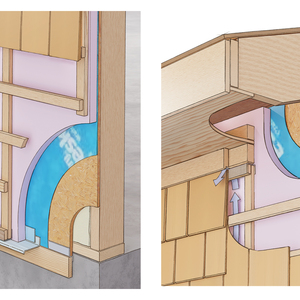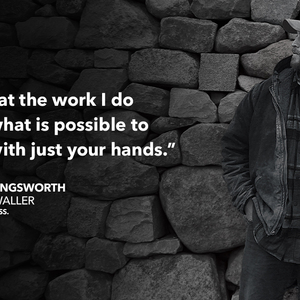I always try and keep my chainsaw chain sharp. I usually get what I think of as normal sawdust when I cut. A couple of times recently, however, I hae seen where people have been cutting and the output is long ribbons of wood. What do they do to get that type of result?
I have tried various means of sharpening with gigs and brackets and various devices for getting the angle of the file exactly on. I usually figure it is too much trouble and just go back to doing it free hand. What is your preferred method of sharpening the chain?



















Replies
I have an expensive (but great) Oregon professional grinder. There's nothing else that will sharpen a chain like that does.
There are so many different types of chain that you have to be very specific about the filing specs for your particular type to get the best performance from it.
I was in a hardware store the other day and a guy was sharpening a chain with a grinder and I knew he was doing it at the wrong angles. I asked him why he was sharpening that particular chain that way and his reply was " we sharpen them all the same way...it don't make no difference"
When you are saying "expensive", I assume you have one of the bench mounted systems that are several hundred dollars. Have you heard of any one's experience with the small Oregon handheld unit that is attached to a 12v battery? I like to sharpen the chain after every tank of gas or two and would like something to use in the field. I have a Dremel attachment for sharpening a chain but haven't used it (can't seem to locate it at the moment...)
Yes, the one I have is over $400 right now. I carry spare sharp chains with me all the time.
The best tool that we ever used in the field was the Oregon clamp on file guide. I think they still make basically the same tool. It was easy to use and very accurate.
Look in the Northern Tool catalog or website for item # 1976-1701. That is either identical to or very similar to the one that Oregon marketed for years.
You can find it here https://www.allicdata.com/products.html
....what's that noise?
"....what's that noise?"Great response! I love it when a joke is so well known that the punch line is all you need to say.
BruceT
Are they ripping or cross cutting when they make those long ribbons? The angles need to be different.
-- J.S.
All the instances where I saw the long ribbons were from bucking tree trunks into fireplace logs, so they would have been crosscutting.
Ribbons are what you want. Dust is a sign of a dull or mis-sharpened chain. An electric chain sharpening tool is a great luxury. Only thing to be careful of with a machine is the tendency to take off too much chain material when sharpening.
However, if you are using the saw for hours at a time you usually won't be able to rely on your chain sharpening machine. You should learn how to sharpen the chain in the field and get ribbons.
The main reason people unfamiliar with the chainsaw don't get the chain sharp with a round file hand system is that they sharpen the side or side corner of the chain tooth. The top flat part of the tooth is what cuts and that's what needs to be sharp. Also if you have sharpened the chain several times the tooth may be cut back where it is below the dogs, the rounded or shark tooth like part of the chainlink right in front of the chisel cutting tooth. That's what the chain rides the log on. File the dog down so it's below the front edge of the chisel tooth. I have plenty of power so I keep my dogs filed way down for an aggressive bite.
Good luck but be very careful, there's a hundred ways to get hurt with one of those things. And never ever stand on a ladder or stool to cut a tree limb.
Thanks for the info.I have been around chainsaws for most of my life, even logged for a while when I was much younger, but don't recall seeing long ribbons until recently. I guess just because the old loggers made their living with a chain saw doesn't mean that their sharpening techniques were the best...
In my old job we used chainsaws alot. I never mastered the sharpening so I would give my saw to my partner and he would sharpen it in under five minutes right on the tailgate with a file from the chainsaw dealer. We would buy them buy them by the box for a couple of bucks each. The saw then would cut great and straight with rectangular chips about 3/8 of an inch long.
Have a good day
Cliffy
Edited 4/17/2007 8:24 pm ET by cliffy
We have a few chainsaws, Do you have a round type chain or chisel bit????? A round chain on a older slower rpm saw will not throw out as much , As for example we have a stihl 64 with chisel bit that throws long ribbons, My stihl 44 with round will not, While you can sharpen the round chains yourself its pretty hard to do the chisel bit one yourself
That's not my experience that a chain that throws long ribbons is sharper than one that doesn't. An even, sharp chain will throw elongated rectangles- 3/8" long or so, like the other fellow said.
I've always found that I would get the long ribbons if I took one or two rakers down a hair too much. The chain could still be razor sharp, but it would make that one tooth wear a bit faster.
Are you taking down your rakers now? That's an important part of sharpening a saw. I always did it with a flat file, by eye- every 4th sharpening or so, one or two small strokes over the rakers. There are also raker guages available to help you file them consistently. With the rakers properly set, the saw will cut more aggresively, and pull itself through the log with little operator effort.
Sharpening a chisel toothed chain is a little more difficult by hand, but it's not bad if you do it fairly often. I never understood the value of any sharpening system that made you take the chain off of the bar- by the time a person takes off the chain, sharpens it, and puts it back on, an experienced sharpener can be cutting again.
zak
"When we build, let us think that we build forever. Let it not be for present delight nor for present use alone." --John Ruskin
"so it goes"
Cliffy and Zak got it right.
You want chips not ribbons, and never dust.
We have one of the bench top sharpeners, and never really ever sharpen chains in the field. When we do a land clearing job we have four chainsaws and usually bring about 5 to 10 chains for each saw. It is quicker to change than sharpen, and we never run them down to very dull. Running them down to very dull is just bad for the teeth, overheating them, and they are easier to sharpen when not that worn down. And a sharp chain cuts quicker and safer.
We probably have around 100 chains for all the saws, so it is just easier when the sharp chain rack gets a little low to sit in a nice comfortable shop and sharpen the rest.
I think our 64 has a skip tooth chain, that throws ribbons to
Edited 4/17/2007 11:25 pm ET by bobbys
I take a 2x4 a bit longer than the bar, draw a centerline down one 4x face and make a bunch of lines in both directions at the proper angle. I put them aboout 3/4" apart in such a way that they cross at the CL.
Then I clamp the 2x4 really good and carefully rip a kerf about 1/2" deep the full length of the board.
Set the guide board on a flat surface, drop the bar in the kerf and hold the file/grinder level and parallel to the lines.
Since I like working from one side, after I sharpen all the right hand teeth, I'll put the saw down in the other end of the guide board and do the keft hand set.
If you do a lot of sharpening in the field, you may want to use a hacksaw to kerf the angle guide lines so they never disappear.
If you have two saws with different angles, flip the guide over and repeat, and label the sides as to which saw uses which side.
SamT
There are three kinds of people: Predaters, Prey, and Paladins. The really strange thing is that Prey feels safer from Predators by disarming Paladins.
I have hand sharpened my chains for the past twenty five years and always gotten excellent cutting performance. The only time I get ribbons coming off the cut is when I am quartering big logs and cutting with the grain rather than crosscutting.
I don't know how you would get ribbons cutting across the grain.
karl
...what Karl said. I'll get ribbons with a sharp chain, strong motor, with the grain, on a softwood log with a shallow cut (a rare occurrence, I don't rip logs often). Otherwise, the best indication of a sharp chain is big chips, which slowly degrade to sawdust as the cutters dull.Scott.Always remember those first immortal words that Adam said to Eve, “You’d better stand back, I don’t know how big this thing’s going to get.â€
Same here. I don't think I have ever seen ribbons except when rip-cutting, which is rare.And I don't see much sawdust either, because it is time to sharpen before the chips get that small.Iuse a file in hand and pop the saw against a log or across my legs so that it leans at the right angle then run the file parrallel to the ground. That way I can see exactly what I am ccutting in the tooth instead of working in the blind
Welcome to the Taunton University of Knowledge FHB Campus at Breaktime. where ... Excellence is its own reward!
I field sharpen by hand and have done it a lot and get good results.
There are a number of benchtop grinders, which are nice if you're using your saws a lot. I have a Silvey, which I bought from a retired logger....new they're about $800.
The best is probably the Dinasaw grinder but it's about $1500.
You can get a decent benchtop grinder for $300 or $400. I like to machine sharpen once for about every 3 or 4 hand sharpenings just to keep the teeth even and the rakers at the right level.
Chains are not all that expensive and it's nice, as someone else pointed out, to go to work with half a dozen or so; then you can stay productive in the field....do the filing at home when you can take you time and do a good job.
It's important that, when sharpening, you keep the teeth at an equal length; otherwise, shorter teeth will be doning little or nothing and your cutting will be slow and wear accelerated. When hand sharpening, count the strokes on each tooth so each is getting equal treatment.
I use chisel bit chains exclusively and there is a hand file for sharping them....it's a three sided file available at most any sawshop. Chisel bits cut much faster, but are dulled more quickly if you get into dirt or sand or rocks.
Okay, I wasn't there when the cutting was done, so they could have been ripping the logs as well as bucking them. I do get small "chunks" rather than "dust" and I do file down the rakers periodically. All three of my saws have chisel teeth, two of them are Oregon chains. I use the recommended round rat tail file and usually use the freehand angle guides. I found the clamp on file guide that I bought for around $40 to be too fussy and too much trouble, but the simple metal guide with the angle scribed on it works reasonably well. I doubt that use my chain saws enough to justify the higher priced grinders. Where I hope to start building soon, Federally mandated zoning though the Columbia Gorge Scenic Act prohibits cutting of trees except were absolutely necessary - although the Forest Service wants wide firebreaks around all the houses...Thanks for all the info, folks.
Well, I definitely like my Echo 440 - starts and runs without stalling, unlike with my recently departed Stihl. It did take a full pulls to get it started the first time. The little Echos have a purge feature in which you press repeatedly on a little bulb and it pushes gas into the carb. The large Echos don't have this. Don't know why as it would be nice to push some gas into the carb when the carb is empty.Cutting at what had been the bottom of the tree trunk, I got chips about half an inch long. At the other end, which had been exposed to the elements and was much softer, I got long ribbons. I thus conclude that the condition of the wood is a critical factor in cutting ribbons vs chips.
Long ribbons has to do with the angle to the grain. try ripping, the teeth act like planes, long ribbons result.
------------------
"You cannot work hard enough to make up for a sloppy estimate."
Hey chap one things for sure you opened up avery old can of worms there ex.twenty different people ,twenty different techniques . what I can tell you is consitancy of angle is important ,ripping a lot you want to make a skip tooth chain {you do use an angle grinder for your rough cut of this} which involves removal of the tops of certain teeth ,you also have a very flat angle on the remaining teeth. ref;a finewoodworking article Will Malloff ,Chainsaw Lumber Making. I've used this adaption to chian for milling for years and love it ! Now if your doing joinery {japanese temple style stuff}with large reclaimed lumber ,wharf beams and such you want to do your marking out cuts with a power saw and take it out with 30 to 35 degree angle . I'm side tracking sorry buy an Oregan file guide and follow the angles on that and remember to flat file the drags a little every fourth or fith sharpen . the other bloke was right you must have seen someone ripping timber down for the long shavings thing to happen .
rule 1 on technique, sharp or dull
keep bar away from hands, legs, and face.....